One of the biggest problems with cycling infrastructure in Oxford is that it is riddled with what I call "dual provision", where two bad options are offered to people cycling instead of one good one. This usually means a choice between cycling on the carriageway (and "pretending to be a car") or cycling on the footway (and "pretending to be a pedestrian") and the absence of any space actually allocated to and designed for cycling.
This kind of "dual provision" can occur along main roads, at junctions, and at crossings. It is quite ubiquitous in Oxford, but I look at just three examples: Woodstock Rd, Frideswide Square, and the Barton Park crossing of the A40.
As Andrew Gilligan wrote in Running Out of Road: "Despite the huge numbers of cyclists using them, Oxford’s main roads and junctions are still laid out almost entirely for the benefit of the motor vehicle. They look little or no different from the roads of a typical British city where almost nobody cycles."
On most of Woodstock Rd, there is a choice between cycling on the footway, where a white painted line marks a notional cycle track, or cycling on the carriageway, where the right to cycle is reinforced by cycle symbols in the general traffic lane or signs authorising cycling in a bus lane. The first option is narrow and undulating, obstructed by trees, bus shelters, lamp posts and other obstacles, and has no priority crossing side streets. It would be seriously - and dangerously - sub-standard even as a one-way cycle track, but as a two-way track it is just farcically bad. The second option involves cycling in 10,000+ motor vehicle per day flows, with some drivers tailgating or overtaking way too close, or using a bus lane (the best option, where available).
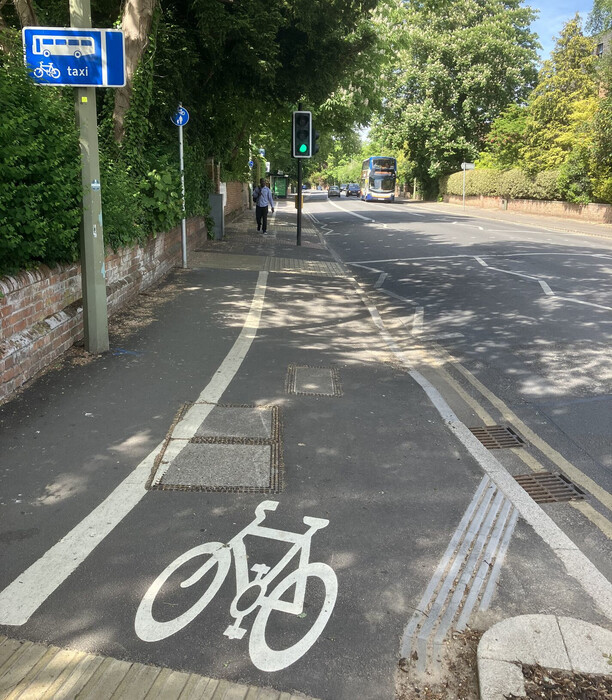
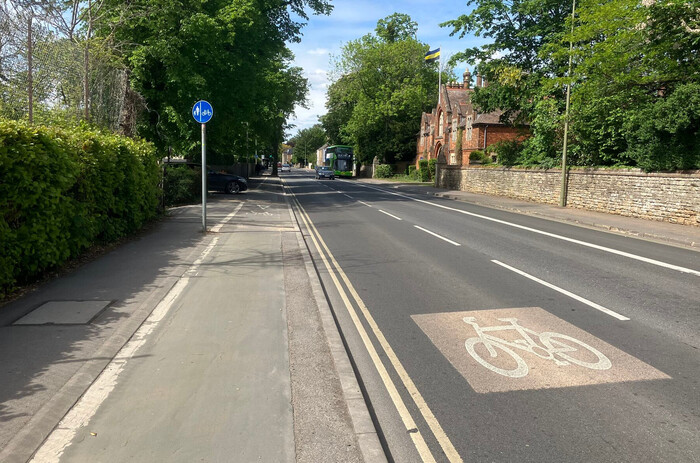
At Frideswide Square, cycling is allowed everywhere (though that is not very obvious). The shared foot-cycle space is broad, but using it still involves weaving around pedestrians, and there is no provision whatsoever for moving between this shared space and the approach roads. This is completely incoherent, illegible, and unsafe. The alternative is to cycle on the carriageway, mixed with 15,000+ motor vehicles per day, including buses and HGVs. This is not accessible (or comfortable).
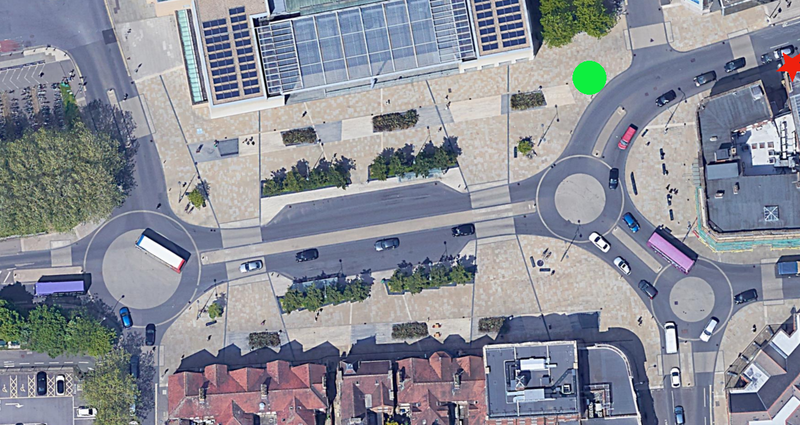
How is someone who doesn't want to mix with motor traffic on the roundels supposed to get from the westbound cycle lane on Hythe Bridge St (red star) to the "cycling space" in front of the business school (green circle)?
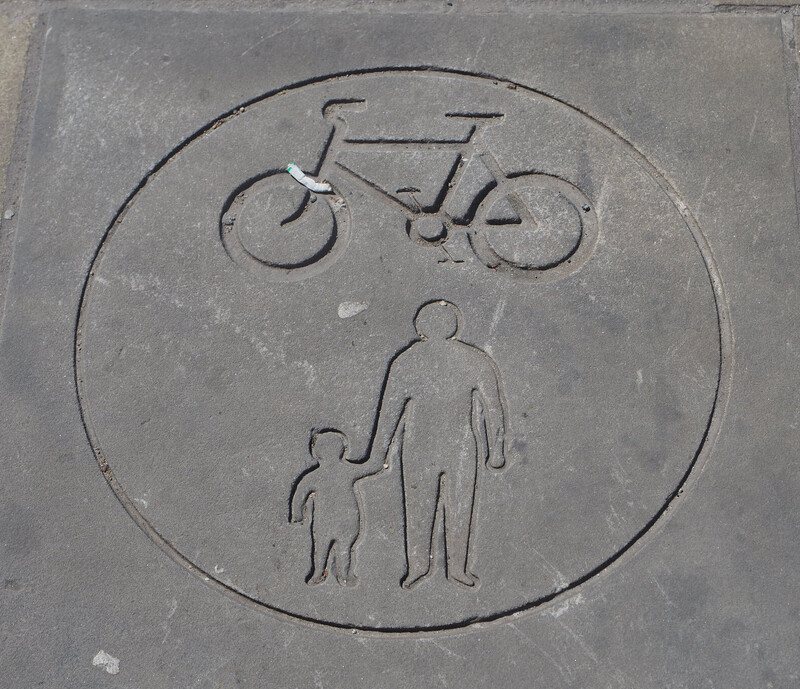
At the Barton Park crossing of the A40 there is a choice between using the pedestrian crossing or cycling across the junction on the carriageway. The pedestrian crossing is a toucan crossing, with cycle lights, but is not otherwise designed for cycling in any way: it involves awkward doglegs and there is no provision for getting onto or off the crossing from the roads on either side. The junction signals provide enough time for a bus to get across, but not enough for slower people cycling.
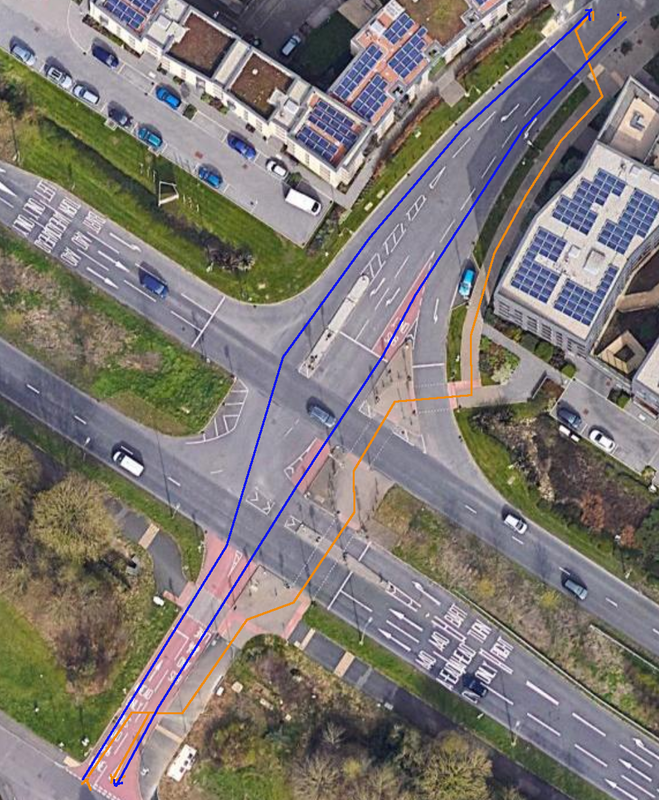
If cycling didn't exist at all, all of these spaces would be laid out in pretty much exactly the same way. A white line drawn down the middle of the footway. A few cycle symbols on the carriageway or footway. A separate cycle symbol on a signal head. That's the entire cycling "infrastructure" in these locations. Support for cycling has either been tacked on afterwards (on Woodstock Rd) or left out of designs by architects (Frideswide Square) or planners (Barton Park) unwilling to acknowledge cycling as a mode of transport that is neither walking nor driving and needs its own space.
What are the problems with this? First of all, it means there is no safe, comfortable, direct, and accessible option for most people. "Pretending to be a car" may be ok for a tiny number of sports cyclists who can sustain 18mph speeds and are used to mixing with motor traffic. (Though they will still end up whizzing around pedestrians when the on-carriageway provision fails to provide them any way to filter when motor traffic congests.) And "pretending to be a pedestrian" may work for four year olds cycling next to walking parents. For everyone else, this is a choice of bad options. Most people don't want to - or simply won't - cycle mixed with bulk traffic flows and HGVs, but still want to be able to get safely get across side streets, not have to dodge around pedestrians and trees, and move at 10 or 12 miles per hour.
"Dual provision" messes with wayfinding: there is no way to make it clear where people cycling should go if there are two (or in some cases more) options for making the same moveoment. And it messes up "legibiity" more broadly: if people can cycle absolutely anywhere, then neither drivers nor pedestrians have any idea where to expect people cycling. This also increases road danger: instead of having a few cycling movements that can be made safe, there are people cycling everywhere, unpredictably: on Woodstock Rd, for example, leaving the carriageway to use the footway to bypass congestion or stopped buses, leaving the footway to go onto the carriageway to make right turns, weaving into the "pedestrian" part of the path to avoid people cycling the other way, and so forth.
To see what Woodstock Rd might look like if it were actually designed to support cycling, we can look at the detailed plans drawn up for it in 2021. These treat cycling as a mode in its own right, with the highway divided into space for walking, space for cycling, and space for motor traffic (with a few foot-cycle shared spaces where unavoidable).
To see what a properly designed cycle crossing might look like at Barton Park, consider the crossings at the Kidlington roundabout. There the sparrow crossings provide separately for walking and cycling, with the cycle crossing connected to cycle tracks on either side, single stage across each arm of the roundabout, and with a low enough signal latency to keep speeds comparable to riding on the carriageway around the roundabout.
And there is a lot of space at Frideswide Square, much of which is not really used at all (to my mind, though it looks nice, Frideswide Square is also a failure as a public realm scheme). It could easily have been designed to accommodate separate cycle tracks and cycle crossings; if this were a Dutch "plein" there would probably be two-way cycle tracks on both the north and south sides of the square.

Danny slightly late to this, but everything you say here is right and there are lots of other examples... I've been cycling in Oxford for some time and have come to the conclusion that despite its Cycling City tag neither the County Council nor the City is really serious about providing decent cycling infrastructure. The cycling groups provide "top cover" to the plans to ease congestion in the city in particular, and the politicians proposing it, there seems to be little payback. The LTN's feel a bit safer but they are a drop in the ocean. In plain terms the infrastructure is poor and provides little confidence even for seasoned cyclists. Of course, the councils are always complaining that they have no funds, but I think it does go deeper than that, and a comparison with Cambridge, as much as I understand it, gives a lie to the idea that nothing can be done. But I don't want to believe this and I do feel there might be some value in starting a social media campaign that points the continuing weaknesses as a way of reminding those that talk about active travel of the state that Oxford is in.